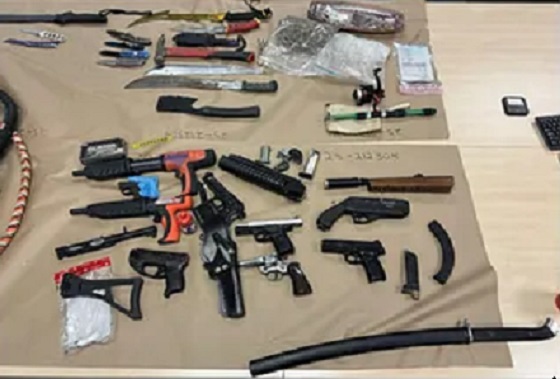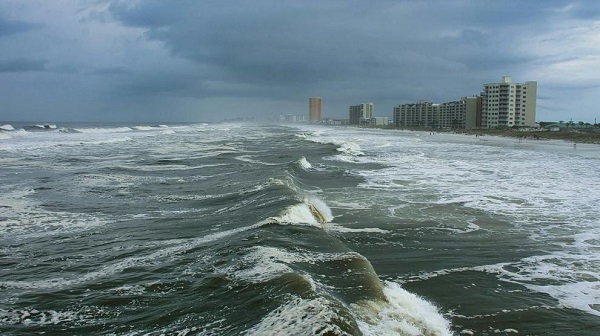Crime
The Bureau Exclusive: The US Government Fentanyl Case Against China, Canada, Mexico

Canadian federal police recently busted a massive fentanyl lab with evident links to Mexico and Chinese crime networks in British Columbia.
Canada increasingly exploited by China for fentanyl production and export, with over 350 gang networks operating, Canadian Security Intelligence Service reports
As the Trump Administration gears up to launch a comprehensive war on fentanyl trafficking, production, and money laundering, the United States is setting its sights on three nations it holds accountable: China, Mexico, and Canada. In an exclusive investigation, The Bureau delves into the U.S. government’s case, tracking the history of fentanyl networks infiltrating North America since the early 1990s, with over 350 organized crime groups now using Canada as a fentanyl production, transshipment, and export powerhouse linked to China, according to Canadian intelligence.
Drawing on documents and senior Drug Enforcement Administration sources—including a confidential brief from an enforcement and intelligence expert who spoke on condition of anonymity due to the sensitivity of the matter—we unravel the evolution of this clandestine trade and its far-reaching implications, leading to the standoff that will ultimately pit President Donald Trump against China’s Xi Jinping.
In a post Tuesday morning that followed his stunning threat of 25 percent tariffs against Mexico and Canada, President Trump wrote:
“I have had many talks with China about the massive amounts of drugs, in particular fentanyl, being sent into the United States—but to no avail. Representatives of China told me that they would institute their maximum penalty, that of death, for any drug dealers caught doing this but, unfortunately, they never followed through, and drugs are pouring into our country, mostly through Mexico, at levels never seen before.”
While Trump’s announcements are harsh and jarring, the sentiment that China is either lacking motivation to crack down on profitable chemical precursor sales—or even intentionally leveraging fentanyl against North America—extends throughout Washington today.
And there is no debate on where the opioid overdose crisis originates.
At a November 8 symposium hosted by Georgetown University’s Initiative for U.S.-China Dialogue on Global Issues, David Luckey, a defense researcher at RAND Corporation, said: “The production, distribution, and use of illegally manufactured fentanyl should be thought of as an ecosystem, and the People’s Republic of China is at the beginning of the global fentanyl supply chain.”
The Bureau’s sources come from the hardline geopolitical camp on this matter. They believe Beijing is attempting to destabilize the U.S. with fentanyl, in what is technically called hybrid warfare. They explained how Canada and Mexico support the networks emanating from China’s economy and political leadership. In Canada, the story is about financial and port infiltration and control of the money laundering networks Mexican cartels use to repatriate cash from fentanyl sales on American streets.
And this didn’t start with deadly synthetic opioids, either.
“Where the drugs come from dictates control. If marijuana is coming from Canada, then control lies there,” the source explained. “Some of the biggest black market marijuana organizations were Chinese organized crime groups based in Brooklyn and Flushing, Queens, supplied from Canada.
“You had organizations getting seven or eight tons of marijuana a week from Canada, all controlled by Chinese groups,” the source said. “And we have seen black market marijuana money flowing back into Canadian banks alongside fentanyl money.”
Canada’s legal framework currently contributes to its appeal for China-based criminal organizations. “Canada’s lenient laws make it an attractive market,” the expert explained. “If someone gets caught with a couple of kilos of fentanyl in Canada, the likelihood of facing a 25-year sentence is very low.”
The presence in Toronto and Vancouver of figures like Tse Chi Lop—a globally significant triad leader operating in Markham, Ontario, and with suspected links to Chinese Communist Party security networks—underscores the systemic gaps.
“Tse is a major player exploiting systemic gaps in Canadian intelligence and law enforcement collaboration,” the source asserted.
Tse Chi Lop was operating from Markham and locations across Asia prior to his arrest in the Netherlands and subsequent extradition to Australia. He is accused of being at the helm of a vast drug syndicate known as “The Company” or “Sam Gor,” which is alleged to have laundered billions of dollars through casinos, property investments, and front companies across the globe.
Reporting by The Bureau has found that British Columbia, and specifically Vancouver’s port, are critical transshipment and production hubs for Triad fentanyl producers and money launderers working in alignment with Mexican cartels and Iranian-state-linked criminals. Documents that surfaced in Ottawa’s Hogue Commission—mandated to investigate China’s interference in Canada’s recent federal elections—demonstrate that BC Premier David Eby flagged his government’s growing awareness of the national security threats related to fentanyl with Justin Trudeau’s former national security advisor.
A confidential federal document, released through access to information, states, according to the Canadian Security Intelligence Service (CSIS): “Synthetic drugs are increasingly being produced in Canada using precursor chemicals largely sourced from China.”
“Preliminary reporting by the BC Coroner’s Service confirms that toxic, unregulated drugs claimed the lives of at least 2,511 people in British Columbia in 2023, the largest number of drug-related deaths ever reported to the agency,” the record says. “CSIS identifies more than 350 organized crime groups actively involved in the domestic illegal fentanyl market … which Premier Eby is particularly concerned about.”
A sanitized summary on Eby’s concerns from the Hogue Commission adds: “On fentanyl specifically, Canada, the United States, and Mexico are working on supply reduction, including as it relates to precursor chemicals and the prevention of commercial shipping exploitation. BC would be a critical partner in any supply reduction measures given that the Port of Vancouver is Canada’s largest port.”
But before Beijing’s chemical narcotics kingpins took over fentanyl money laundering networks from Canada, the story begins in the early 1990s when fentanyl first appeared on American streets, according to a source with full access to DEA investigative files.
The initial appearance of fentanyl in the United States was linked to a chemist in Ohio during 1992 or 1993, they said. This illicit operation led to hundreds of overdose deaths in cities like Chicago and New York, as heroin laced with fentanyl—known as “Tango & Cash”—flooded the streets. The DEA identified and dismantled the source, temporarily removing fentanyl from the illicit market.
Fentanyl seemed to vanish from the illicit market, lying dormant.
The mid-2000s saw a resurgence, this time with Mexican cartels entering the methamphetamine and fentanyl distribution game, and individuals of Chinese origin taking up roles in Mexico City. “One major case was Zhenli Ye Gon in 2007, where Mexican authorities seized $207 million from his home in Mexico City,” The Bureau’s source said. “He was a businessman accused of being involved in the trafficking of precursor chemicals for methamphetamine production.”
Ye Gon, born in Shanghai and running a pharma-company in Mexico, was believed to be perhaps the largest methamphetamine trafficker in the Western Hemisphere. Educated at an elite university in China, he made headlines not only for his alleged narcotics activities but also for his lavish lifestyle. While denying drug charges in the U.S., he claimed he had received duffel bags filled with cash from members of President Felipe Calderón’s party—a claim that was denied by officials. His arrest also caused a stir in Las Vegas, where Ye Gon was a “VIP” high roller who reportedly gambled more than $125 million, with the Venetian casino gifting him a Rolls-Royce.
Despite high-profile crackdowns, the threat of fentanyl ebbed and flowed, never truly disappearing.
Meanwhile, in 2005 and 2006, over a thousand deaths on Chicago’s South Side were traced to a fentanyl lab in Toluca, Mexico, operated by the Sinaloa Cartel. After the DEA shut it down, fentanyl essentially went dormant again.
A new chapter unfolded in 2013 as precursor chemicals—mainly N-phenethyl-4-piperidone (NPP) and 4-anilinopiperidine (4-ANPP)—began arriving from China. This is when fentanyl overdoses started to rise exponentially in Vancouver, where triads linked to Beijing command money laundering in North America.
“These chemicals were entering Southern California, Texas, and Arizona, smuggled south into Mexico, processed into fentanyl, and then brought back into the U.S., often mixed with Mexican heroin,” the U.S. government source explained.
At the time, a kilo of pure fentanyl cost about $3,000. By 2014, it was called “China White” because heroin was being laced with fentanyl, making it far more potent. In February 2015, the DEA issued its first national alert on fentanyl and began analyzing the role of Chinese organized crime in the fentanyl trade and related money laundering.
The profitability and efficiency of fentanyl compared to traditional narcotics like heroin made it an attractive commodity for drug cartels.
By 2016, fentanyl was being pressed into counterfeit pills, disguised as OxyContin, Percocet, or other legitimate pharmaceuticals. Dark web marketplaces and social media platforms became conduits for its distribution.
The merging of hardcore heroin users and “pill shoppers”—individuals seeking diverted pharmaceuticals—into a single user population occurred due to the prevalence of fentanyl-laced pills. This convergence signified a dangerous shift in the opioid crisis, broadening the scope of those at risk of overdose.
The profitability for traffickers was staggering. One pill could sell for $30 in New England, and Mexican cartels could make 250,000 pills from one kilo of fentanyl, which cost around $3,000 to $5,000. This was far more lucrative and efficient than heroin, which takes months to cultivate and process.
This shift marked a significant turning point in the global drug trade, with synthetic opioids overtaking traditional narcotics.
By 2016, entities linked to the Chinese state were entrenched in Mexico’s drug trade. Chinese companies were setting up operations in cartel-heavy cities, including mining companies, import-export businesses, and restaurants.
“The growth of Chinese influence in Mexico’s drug trade was undeniable,” the source asserted.
Recognizing the escalating crisis, the DEA launched Project Sleeping Giant in 2018. The initiative highlighted the role of Chinese organized crime, particularly the triads, in supplying precursor chemicals, laundering money for cartels, and trafficking black market marijuana.
“Most people don’t realize that Chinese organized crime has been upstream in the drug trade for decades,” the U.S. expert noted.
When the COVID-19 pandemic hit in 2020, drug trafficking organizations adapted swiftly. With borders closed and travel restricted, cartels started using express mail services like FedEx to ship fentanyl and methamphetamine.
This shift highlighted the cartels’ agility in exploiting vulnerabilities and adapting to global disruptions.
By 2022, the DEA intensified efforts to combat the fentanyl epidemic, initiating Operation Chem Kong to target Chinese chemical suppliers.
An often-overlooked aspect of the drug trade is the sophisticated money laundering operations that sustain it, fully integrated into China’s economy through triad money brokers. Chinese groups are now the largest money launderers in the U.S., outpacing even Colombian groups.
“We found Chinese networks picking up drug money in over 22 states,” the source explained. “They’d fly one-way to places like Georgia or Illinois, pick up cash, and drive it back to New York or the West Coast.”
Remarkably, these groups charged significantly lower fees than their Colombian counterparts, sometimes laundering money for free in exchange for access to U.S. dollars.
This strategy not only facilitated money laundering but also circumvented China’s strict currency controls, providing a dual benefit to the criminal organizations.
They used these drug-cash dollars to buy American goods, ship them to China, and resell them at massive markups. Chinese brokers weren’t just laundering fentanyl or meth money; they also laundered marijuana money and worked directly with triads. Operations like “Flush with Cash” in New York identified service providers moving over $1 billion annually to China.
But navigating the labyrinth of Chinese criminal organizations—and their connectivity with China’s economy and state actors—poses significant challenges for law enforcement.
“The challenge is the extreme compartmentalization in Chinese criminal groups,” the U.S. expert emphasized. “You might gain access to one part of the organization, but two levels up, everything is sealed off.”
High-level brokers operate multiple illicit enterprises simultaneously, making infiltration and dismantling exceedingly difficult.
The intricate tapestry of Chinese fentanyl trafficking highlights a convergence of international criminal enterprises exploiting systemic vulnerabilities across borders. The adaptability of these networks—in shifting trafficking methods, leveraging legal disparities, and innovating money laundering techniques—poses a formidable challenge to Western governments.
The leniency in certain jurisdictions including Canada not only hinders enforcement efforts but also incentivizes criminal activities by reducing risks and operational costs.
As the United States prepares to intensify its crackdown on fentanyl networks, having not only politicians and bureaucrats—but also the citizens they are serving—understand the importance of a multifaceted and multinational counter strategy is critical, because voters will drive the political will needed.
And this report, sourced from U.S. experts, provides a blueprint for other public interest journalists to follow.
“This briefing will help you paint the picture regarding Chinese organized crime, the triads, CCP, or PRC involvement with the drug trade and money laundering—particularly with precursor chemicals and black market marijuana,” the primary source explained.
The Bureau is a reader-supported publication. To receive new posts and support my work, consider becoming a paid subscriber.
Crime
Vancouver police seize fentanyl and grenade launcher in opioid-overdose crisis zone

Vancouver police say they have seized a grenade launcher, four guns, and nearly 500 grams of fentanyl and other hard drugs from a fortified Downtown Eastside rooming house that was allegedly feeding a synthetic opioid supply line through the city’s most drug-ravaged blocks.
“Task Force Barrage has come to an end, but our work to curb violence and disrupt organized crime in the Downtown Eastside continues,” Sergeant Steve Addison said, adding “the proliferation of violence and weapons in some residential buildings continues to put the neighbourhood at risk.”
The latest investigation began November 13, when a 42-year-old man suffered serious injuries in an assault near Carrall Street and East Cordova and was taken to hospital. Officers followed leads to a rooming house at 50 East Cordova Street, in the heart of a street-level open drug market that has become notorious in photos and news clips around the world.
On November 18, police say they uncovered a stockpile of illicit drugs, guns and weapons in three rooms of the East Cordova building. According to Addison, there are signs that parts of the property, which is supposed to house low-income residents, were repurposed as a hub to store weapons and distribute contraband throughout the neighbourhood, with some areas “fortified with countersurveillance measures to avoid detection from law enforcement.”
Items seized include four firearms, two imitation guns, a grenade launcher, a firearm suppressor, seven machetes, four flare guns, bullwhips, baseball bats, body armour, handcuffs and ammunition. Officers also seized 486 grams of fentanyl, cannabis, Dilaudid pills and methamphetamine – a quantity police say represents more than 2,500 single doses.
Meanwhile, in a separate update posted November 26 — the day before VPD announced the Cordova Street raid — Vancouver Fire Rescue Services said that on Tuesday, November 21, firefighters responded to 54 overdoses, the highest single-day total in the department’s history. The service said it averaged about 16 overdose calls per day in May, but that figure has surged in recent weeks, and during the most recent income-assistance week, firefighters were averaging roughly 45 overdose responses per day.
While police have not publicly linked the East Cordova seizure to any specific cartel, the mix of fentanyl, fortified real estate and a small armoury of weapons closely tracks the profile of a separate, high-profile British Columbia case in which provincial authorities say a Sinaloa Cartel–aligned cell embedded itself just south of Vancouver.
In that case, a civil forfeiture lawsuit alleged a Sinaloa Cartel–linked fentanyl and cocaine trafficking group set up in a multi-million-dollar mansion near the U.S. border, capable of negotiating major cocaine import deals with Ismael Garcia—known as “El Mayo”—the reputed Sinaloa Cartel chief. According to the filings, the Canada-based syndicate involved at least three men, and belonged to a violent drug trafficking organization that “used and continues to use violence, or threats of violence, to achieve its aims.”
Investigators alleged the Surrey-based group trafficked ketamine, methamphetamine, Xanax, oxycodone, MDMA and fentanyl. “As part of these efforts, the drug trafficking organization has agreed to, and made arrangements to, purchase cocaine from the Cártel de Sinaloa in Mexico,” the filings stated. They added: “the Sinaloa Cartel is a terrorist entity, and the government of Canada listed it as such on February 20, 2025.”
RCMP said they uncovered a substantial cache of weapons and narcotics during a search of the Surrey property on 77th Avenue on September 23, 2024. Opioids seized from the mansion included 400 grams of counterfeit Xanax, 810 oxycodone pills, 5.5 grams of fentanyl and nearly a kilogram of Ecstasy. The province is now seeking forfeiture of the house, which sits about 20 minutes from the Peace Arch border crossing north of Seattle.
Court submissions detailed an arsenal of 23 weapons – ten handguns, two sawed-off shotguns, two hunting rifles, seven assault rifles (two reportedly fitted with screw-on suppressors), and a speargun – alongside about 3.5 kilograms of ketamine and methamphetamine hidden in a compartment in one suspect’s room, hundreds of counterfeit alprazolam pills, a stash of oxycodone, and nearly CAD 15,000 in bundled cash “not consistent with standard banking practices.”
Viewed together, the Downtown Eastside raid and the Surrey mansion case sketch out different ends of what appears to be the same continuum, ultimately pointing to senior criminal leaders in Mexico and China.
The Bureau is a reader-supported publication.
To receive new posts and support my work, consider becoming a free or paid subscriber.
Crime
B.C.’s First Money-Laundering Sentence in a Decade Exposes Gaps in Global Hub for Chinese Drug Cash

Port Coquitlam Mayor Brad West met with Biden Secretary of State Antony Blinken in 2023, to discuss Canada’s enforcement gap on fentanyl money laundering.
Chinese underground-banking conviction is a baby step in a jurisdiction that some experts see as North America’s center of gravity for transnational crime.
In a milestone that is staggering for its rarity in a jurisdiction regarded as a global nexus of Chinese transnational money laundering that facilitates fentanyl trafficking for Mexican and Iranian gangs, British Columbia’s anti-gang unit has finally secured its first money laundering sentencing in a decade.
On Monday, a B.C. Supreme Court judge sentenced 37-year-old Richmond resident Alexandra Joie Chow to 18 months in jail for laundering the proceeds of crime, following a six-year investigation that targeted illegal Chinese underground casinos and unlicensed money transfer businesses in Metro Vancouver. The court also ordered the forfeiture of cash and bank drafts seized during the probe, the Combined Forces Special Enforcement Unit of B.C. (CFSEU) says.
Chow’s case marks the first time in roughly ten years that a money-laundering investigation in British Columbia has actually resulted in a sentencing — a remarkable data point in a province where hundreds of billions have washed through casinos, banks and real estate, according to The Bureau’s estimates, yet almost no one has been successfully prosecuted for the underlying financial crime.
While Chow’s case in itself is relatively small in dollar terms, it followed the catastrophic collapse of the RCMP’s E-Pirate probe into a Richmond underground bank called Silver International, which was alleged to have laundered over $1 billion through a network of Chinese Triad leaders known as “Sam Gor” or “The Company” — a scheme that moved drug cash collected in Chinese diasporas across North and Latin America, cycling the funds back to hundreds of accounts in China, in part through lending gang cash to Asian high-rollers who washed massive sums through B.C. government casinos.
The collapse of E-Pirate raised significant concerns in Washington around Canada’s capacity to prosecute fentanyl money laundering and trafficking. Vancouver-area Mayor Brad West has told The Bureau that the failure of Canadian authorities to secure convictions in that case was explicitly noted in 2023 by senior figures in the Biden administration, including Secretary of State Antony Blinken, in discussions about Canada’s role in North American drug trafficking.
Chow pleaded guilty in February 2025 to one count of laundering proceeds of crime after prosecutors alleged she was part of an underground loan-sharking and money-services scheme that operated in the Lower Mainland. Her plea came almost two years after B.C.’s Joint Illegal Gaming Investigation Team first announced charges.
The trail to that conviction began in August 2019, when B.C.’s Joint Illegal Gaming Investigation Team (JIGIT) quietly launched an investigation into the alleged loan-sharking and money-laundering activities of a man and a woman. Investigators believed the suspects were charging criminal interest rates and operating an unlicensed money services business.
Over the course of the probe, police say they developed evidence that the suspects allegedly laundered more than $828,000 in Canadian cash. On November 5, 2021, JIGIT executed a series of search warrants on properties in Richmond and Burnaby, as well as three vehicles associated to the investigation.
The searches resulted in the seizure of a number of items believed to be tied to money laundering and loan-sharking, including score sheets with client names and payment due dates, four cellular phones, two bank drafts totaling $50,000, and $10,680 in Canadian currency and three high-end vehicles.
Two years later, on November 1, 2023, the B.C. Prosecution Service approved four sets of charges against Chow: money laundering, possessing proceeds of crime, and entering into agreements to receive criminal-rate interest — classic loan-sharking. No other individuals were ultimately charged in the case.
As CFSEU-BC media officer Sgt. Sarbjit Sangha put it in the unit’s statement Monday, this is “the first time in a decade that a money laundering investigation in British Columbia has resulted in a sentencing,” and it “underscores the impact of collaborative investigative work” and JIGIT’s mandate to tackle illegal gaming tied to organized crime, loan-sharking and sophisticated bookmaking.
The scale of the enforcement gap this case exposes is critical to understanding current irritants between Washington and Ottawa, and the Trump administration’s leverage of tariffs on Canada. That campaign of economic pressure, some U.S. and Canadian officials have informed The Bureau, apparently extends from deep concerns in both the Biden and Trump administrations over Ottawa’s lack of meaningful action against massive money laundering through Canada’s financial system — including the TD Bank fentanyl money laundering case prosecuted in the Tri-State area, which exposed transactions similar to those revealed in the Chow investigation in Richmond.
The Cullen Commission into money laundering in B.C. found that by 2014, casinos in the province were accepting nearly $1.2 billion in cash transactions of $10,000 or more in a single year, many involving patrons who showed classic indicators of criminal cash — bricks of small bills delivered in bags by couriers closely watched by organized-crime investigators. JIGIT itself was created as part of the province’s response to that crisis. In a 2021 presentation to the Cullen Commission, then-Unit Commander Staff Sgt. Joel Hussey explained that JIGIT’s money-laundering and loan-sharking probes were focused on “top-tier” organized criminals exploiting casinos and banks, particularly at Richmond’s River Rock Casino Resort, Vancouver’s Parq Casino and Burnaby’s Grand Villa, where investigators saw the most entrenched high-roller criminal activity.
Yet the province’s record in actually getting such cases to the finish line has been abysmal. The most notorious example remains E-Pirate, the massive RCMP investigation that targeted Silver International, a Richmond underground bank alleged to be moving over $1 billion a year in drug and casino cash for Chinese and Mexican cartels and Middle Eastern networks. That case collapsed in 2018–2019 after federal prosecutors mistakenly exposed a confidential informant, leading to a stay of charges despite years of work and huge evidence seizures.
International bodies such as the Financial Action Task Force later used E-Pirate as a case study, describing a “professional” Richmond-hub laundering network that allegedly used B.C. casinos and real estate to clean and move drug proceeds on a global scale. Cullen’s final report, released in 2022, concluded that sophisticated money-laundering networks were moving “staggering amounts” of illicit funds through B.C., while law-enforcement and regulatory agencies failed to respond in a timely or coordinated way.
Whether Chow’s 18-month sentence becomes a template for future Vancouver Model prosecutions — or remains an isolated success in a province still struggling to hold money launderers to account — will be the next test for B.C.’s anti-gang and financial-crime enforcement regime.
Those questions are not just academic in Ottawa. As The Bureau has previously reported, senior officials in Washington — Democrats and Republicans alike — have for years warned that Canada’s failure to deliver sustained proceeds-of-crime prosecutions, and its lack of a RICO-style racketeering law, has turned the country into a structural weak point in North America’s fight against cartel-linked fentanyl networks.
As reported previously by The Bureau, in a high-level meeting in 2023, according to Vancouver-area Mayor Brad West, a longstanding critic of transnational drug networks in his province, Secretary of State Antony Blinken stressed that Washington believes Beijing is effectively weaponizing fentanyl against North Americans—and that Canada stands out as a worrisome weak link in the global supply chain.
West, reflecting on his encounter with Blinken, argued that only bold legislative change, coupled with a willingness to challenge entrenched legal barriers, can dispel the U.S. government’s unease over Canada’s approach. “Secretary Blinken specifically noted the lack of a RICO-style law in Canada,” West said. “He talked about how, in the United States, that law had been used to take down large portions of the mafia. Then he looked at us—one of America’s closest allies—and saw a very concerning weak link.”
According to West, Blinken pointed to China’s role in funneling precursor chemicals into fentanyl labs. He warned that China’s government, if inclined, could stem the flow but has little interest in doing so. “He was incredibly candid,” West recalled. “He confirmed the connection between the Chinese Communist Party, the triads, and the Mexican cartels, telling me these groups are working together—and it’s Canada where they’re finding a safe operating base.”
Blinken also conveyed to West that U.S. agencies had grown hesitant to share certain intelligence with their Canadian counterparts. “He told me that U.S. intelligence and law enforcement are withholding some evidence because they don’t believe we’ll act on it,” West explained. “They’ve lost confidence.”
West added that in ongoing communications, he had learned American officials are shocked that major figures in Asian organized crime “seem to have so much access to our political class. They’re basically saying, ‘What’s going on in Canada?’”
A major concern, according to West, is how known criminals manage to appear at political events or fundraisers with little oversight. “It’s not necessarily that politicians are complicit, but our political structures have weak guardrails,” West said. “The Americans see pictures of transnational criminals mingling at official gatherings and find it baffling.”
The Bureau is a reader-supported publication.
To receive new posts and support my work, consider becoming a free or paid subscriber.
-

 Alberta2 days ago
Alberta2 days agoEmissions Reduction Alberta offering financial boost for the next transformative drilling idea
-

 Business1 day ago
Business1 day agoRecent price declines don’t solve Toronto’s housing affordability crisis
-

 armed forces2 days ago
armed forces2 days agoGlobal Military Industrial Complex Has Never Had It So Good, New Report Finds
-

 International2 days ago
International2 days agoAtlantic hurricane season is 8th this century with no landfalls
-

 Daily Caller1 day ago
Daily Caller1 day agoTech Mogul Gives $6 Billion To 25 Million Kids To Boost Trump Investment Accounts
-

 Alberta24 hours ago
Alberta24 hours agoAlberta will defend law-abiding gun owners who defend themselves
-

 Business1 day ago
Business1 day agoOttawa’s gun ‘buyback’ program will cost billions—and for no good reason
-

 Business1 day ago
Business1 day agoCanada’s future prosperity runs through the northwest coast










